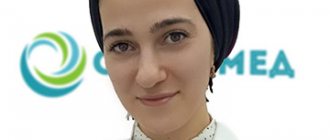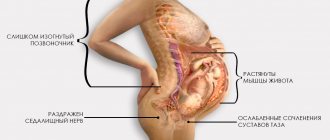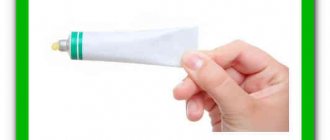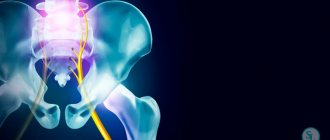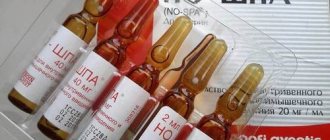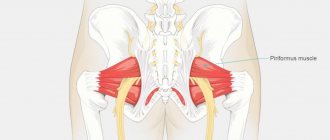Types of lumboischialgia
According to the method of progression, lumboischialgia is divided into 2 forms:
- acute – characterized by acute lumbago that occurs for the first time;
- chronic - pain (they are nagging and dull) appears periodically and systematically, periods of exacerbation are replaced by remission.
Depending on the affected area, lumbago with sciatica occurs:
- unilateral – pathology covers the right or left side of the body;
- bilateral, or bilateral - inflammation spreads to both sides.
Depending on the cause, lumbar sciatica is distinguished:
- vertibral, or vertebrogenic – caused by diseases of the spine:
- discogenic – develops with intervertebral hernia;
- spondylogenic – caused by osteochondrosis;
- nonvertebrogenic – not associated with diseases of the spine:
- angiopathic - provoked by disruptions in the blood circulation of the lower back and lower extremities;
- myofascial – a consequence of damage to muscles and fascia;
- caused by pathologies of the peritoneal organs;
- caused by problems in the hip joints;
- idiopathic - the cause cannot be determined.
The use of massage for sciatica
Let us dwell a little on the reasons why massage as a method provides serious assistance in the fight against inflammation and pain symptoms:
- The main positive effect is normalization of tissue blood circulation and improvement of lymph outflow . This helps, among other things, relieve swelling.
- Removing muscle blocks and relaxing muscles . This allows you to relieve the sciatic nerve and blood vessels from spasms.
- (acupressure) method This helps cope with inflammation and relieve spasms using the body's reserves.
Massage for sciatica can be general or local (only on the affected area).
Depending on the stage of exacerbation or remission, they do:
- Relaxing massage. In the acute stage, this is the only thing you can do.
- Massotherapy. It is used only in the absence of exacerbation and for its prevention. This type of massage is more intense and should be performed by a specialist.
Depending on the part of the nerve lesion (upper or lower sciatica), in addition to the back, the arms or legs are also massaged.
In addition to traditional manual massage for sciatica, these types are very effective and widely used:
- Vacuum (can). It can be targeted (“place the jars”) or dynamic – moving the jar across the skin.
- Acupressure (point). If we are talking about a full-fledged acupressure massage, where you need to know well which point in the body is responsible for what, it should only be performed by a specialist so as not to cause harm. But stimulation of several standard points in the treatment of sciatica (we will discuss them below) can be performed independently.
- Honey massage. A relaxing type of massage, also suitable for home use.
Massage is not used for exacerbation of sciatica. In general, massage is considered a safe method for sciatica and has almost no contraindications.
Obvious contraindications are only purulent tissue lesions or skin diseases in the area of impact and spinal injuries, which require caution and only a qualified approach (depending on the doctor’s testimony).
And, as already mentioned, sciatica in the acute stage is a contraindication for therapeutic massage , which includes intense techniques (squeezing, rubbing, vibration).
The effectiveness of massage also depends on what caused the pain. With one pinched nerve, the method gives the maximum effect, but if there is inflammation, it is used as an auxiliary method.
In this case, drug treatment cannot be ignored. For inflammation, warming ointments are usually used, including massage.
Want to know how to treat sciatica at home? Pay attention to the following articles :
- How is medication treated for sciatica and how effective is it?
- You can read about the use of injections for sciatica at this link
- The treatment of sciatica using traditional methods is described on the next page
Causes of pathology
The disease develops when the sciatic nerve is pinched, injured or inflamed.
A variety of factors can cause this situation:
- injury to the back area;
- radicular syndrome;
- chronic diseases of the spine (osteochondrosis, intervertebral hernia, arthrosis, osteoporosis, spondylitis, scoliosis, protrusion);
- benign or malignant neoplasms in the spinal column;
- infections affecting nerve trunks;
- inflammation of the back muscles;
- inflammatory processes in the blood vessels of the sacrum;
- pathologies of the hip joint;
- diseases of the abdominal organs;
- prolonged sitting;
- unsuccessful injections into the epidural cavity;
- postoperative complications.
They increase the risk of developing the disease and provoke relapses in the chronic form:
- hypothermia of the body;
- prolonged stay in an uncomfortable position;
- long work at the computer;
- improper performance of exercises during sports;
- increased physical activity;
- constant work in the garden (sometimes lumboischialgia is called summer residents’ disease);
- poor posture;
- age-related degenerative processes in the spine;
- excess weight;
- frequent stressful situations;
- depression;
- pregnancy;
- alcohol abuse;
- smoking.
Causes of inflammation
Let us dwell on the basic prerequisites that can lead to inflammatory processes of the sciatic nerve.
Among the reasons that can provoke the problem, we note:
- complete or partial displacement of the intervertebral disc;
- the appearance of osteochondrosis;
- infections (sepsis, typhus, syphilis, influenza, tuberculosis);
- intervertebral hernia;
- hypothermia
Sciatica can be caused by malignant or benign tumors of the vertebrae, poisoning (arsenic, mercury, lead), internal bleeding, arthritis.
Symptoms of the disease
The main symptom of lumboischialgia is acute lumbago (sharp pain of a shooting nature) in the buttocks and back of the legs, radiating to the lower extremities. The pain is provoked by sudden movements, lifting heavy objects, sneezing, coughing. Attacks can last several minutes or several days.
The patient may experience other symptoms:
- decreased or loss of sensitivity in the skin of the buttocks and affected leg;
- stiffness in the lower back;
- muscle tension;
- pain when standing on your leg;
- cramps in the calf muscle;
- numbness of the toes;
- pallor of the skin in the sacral area;
- increased body temperature;
- chills and fever;
- weakness in the legs;
- indigestion;
- difficulty and pain in urination and defecation;
- itching, burning or subcutaneous throbbing.
If left untreated, blood circulation is impaired. Over time, lumbago with sciatica can cause urinary and fecal incontinence, sexual dysfunction, cause a decrease in muscle mass in one limb, and lead to disability.
Causes of pinching and how to recognize the disease
There are many reasons why a pinched sciatic nerve can occur. Among the main ones that patients treat in St. Petersburg, the massage master notes injuries, arthritis and arthrosis, and hypothermia. Excessive physical activity, improper lifting of weights, and even sudden, careless movements can also lead to sciatica. Various diseases can also cause pinching. For example, diabetes, obesity. This ailment is common in pregnant women who require specific massage.
Sciatica can have pronounced symptoms or be disguised as unpleasant sensations. Pinching may be indicated by heaviness in the legs, increased fatigue when walking, pain in the muscles and joints of the legs. Sensation in the lower extremities decreases, and it becomes difficult for a person to lead a normal lifestyle.
In addition to general physical sensations, pinched sciatic nerve must be confirmed clinically. Before prescribing therapy in the city of St. Petersburg, the massage master must determine the nature of the pinching and the exact area. To do this, the patient needs to have an X-ray of the spine, CT, MRI, and EPI of the neuromuscular system. In addition to these studies, it is required to take a general blood test, which will show the presence of inflammatory processes in the body. You can start massage only after the acute inflammatory phase and pain have passed.
Diagnostics
The doctor will be able to draw preliminary conclusions by studying the medical history and examining the affected area.
To confirm the diagnosis, determine the cause of the disease and determine the condition of the tissues, he refers the patient for diagnostics:
- radiography;
- ultrasonography;
- densitometry;
- computed or magnetic resonance imaging;
- blood test for infections and autoimmune diseases;
- analysis for tumor markers (if a tumor is suspected).
Types of massage
The process of treating sciatica at all stages can be perfectly complemented by massage. If you combine it with physical activity (physical therapy classes) and ointments (find out which ointments are recommended here), the effect will not take long to appear. Let's take a closer look at the three most popular types of massage for sciatica - cupping, acupressure and honey . The desired number of sessions for each of them is from seven to ten.
Vacuum/cupping massage
Cupping massage for sciatica at home is also called vacuum massage, since it requires glass jars - they create a pressure difference that has a beneficial effect on the condition of the pinched nerve.
To begin the procedure, you will need completely dry jars. Before starting the procedure, the skin is smeared with a special oil. Next, take a jar and create reduced pressure in it using fire.
A small torch (more like a long match) is briefly placed in the jar, the air burns out from the flame, the air currents begin to move, and the jar is ready for use. After exposure to flame, it is immediately applied to the skin, to the affected area. The skin will be pulled into the jar by 1–1.5 centimeters.
The cups are placed along the pinch line, paying special attention to the lower back. Then you should perform massage movements. They should be smooth and continuous. Take the jar with your fingers and move it in a spiral, zigzag and back and forth. The patient will feel warmth and a slight burning sensation.
Slight pain is possible , as sciatica will make itself felt. The duration of the session is from five to fifteen minutes. It is recommended to repeat sessions daily or every other day. After completing the procedure, it is advisable to perform a light stroking massage and let the patient lie down for about 20 minutes in a relaxed state, wrapped in a warm blanket.
We suggest that you familiarize yourself with other methods of treating sciatica at home, as well as all possible symptoms and ways to quickly relieve pain.
Acupressure
Acupressure for sciatica at home is performed without the use of devices, but exclusively with your fingers. The method is not suitable for self-medication.
The complexity of the technique lies in the large number of active points, which are not easy to find (let alone influence them) on your own. However, the effectiveness of the method is considered very high ; after one or two sessions the patient feels much better.
At the first stage, the massage therapist palpates (feels) the affected area of the lower back. It identifies the most painful and problematic point of the sciatic nerve. Then the doctor performs sedative massage of the sore point, its circumference and buttocks. The massage therapist works on the affected area with circular movements, counterclockwise.
The most commonly massaged points are V23, V47, V40, VC6. Two of them are located in the lumbar region, V40 is located in the popliteal fossa, and VC6 is on the abdomen. The last stage is massaging the meridian points of the bladder.
Honey massage for sciatica
Massage using honey is actually more similar to using ointments and gels. Massage movements occupy a small part of the procedure. Honey is a biologically active substance and is widely used to treat all types of diseases.
To begin the procedure, apply a tablespoon of heated honey to the lower back and rub it evenly. Then wait 2-3 minutes for it to be absorbed. Next, rub in the remaining honey and lightly pat it. The patient may have an unpleasant painful sensation, as if the skin is being pulled back. At the end, the lumbar region is wiped with a damp cloth and the back is wrapped in a blanket.
Treatment methods
Treatment of lumboischialgia consists of two stages: medication and complex.
Drug therapy is aimed at eliminating muscle spasms and relieving pain. The patient must be prescribed bed rest (for a couple of weeks). In this case, the bed should be flat and firm. For particularly severe pain, it is recommended to use a corset.
Drug treatment includes taking:
- anti-inflammatory medications – relieve inflammation, relieve pain;
- analgesics – relieve pain;
- muscle relaxants - eliminate muscle spasms;
- vasodilators - activate blood circulation and accelerate metabolism;
- diuretics – have a diuretic effect, eliminate swelling, remove toxins from the body;
- antidepressants – relieve depression, nervousness, fears;
- vitamin complexes - provide the body with useful substances, accelerate regeneration, help restore nerve structures and improve conductivity.
Local agents (ointments, creams and gels) that improve blood circulation and have an analgesic effect will help increase the effectiveness of treatment. For severe, unremitting pain, blockades with novocaine or glucocorticosteroids are made.
Under no circumstances should you massage or knead the sore area, as this can lead to a significant deterioration in your well-being.
After the pain disappears, they move on to the second stage, aimed at eliminating the cause of the pathology.
For complex therapy the following is used:
- physiotherapeutic procedures (shock wave therapy, ultra-high frequency therapy, ultraviolet irradiation, electrophoresis, ionization, Bernard currents, laser therapy, magnetotherapy, electrotherapy, diathermy, reflexology, ozone therapy, muscle relaxation, paraffin baths) - effectively relieve inflammation and pain, restore the functionality of the lower back;
- physical therapy – special exercises are selected to relieve pinched nerves.
Additionally, you can use traditional medicine recipes.
In difficult cases (for example, if lumboischialgia is combined with an intervertebral hernia), surgical intervention is resorted to.
Shock wave therapy treatment
Among physiotherapeutic procedures, shock wave therapy is the most effective.
During the procedure, the affected tissues are exposed to acoustic shock waves of a given frequency, which are generated by a special sensor. The therapy has a complex effect on all components of the pathological process: destroys salt deposits, increases blood flow in capillaries tens (and sometimes hundreds) times, normalizes metabolism, improves cell nutrition, eliminates muscle spasms and inflammation, relieves pain, and restores spinal mobility . In addition, it activates the body’s own forces, contributing to its restoration and return to a full life.
Quite often, when drug treatment fails, shock wave therapy leads to complete recovery, making it a worthy alternative to injections and avoiding surgical treatment.
To increase the effectiveness of the procedure, individual parameters are selected on the device for each patient, taking into account the general condition of the body and associated pathologies.
The full course of treatment includes 8-10 weekly procedures.
Features of relieving inflammation of the sciatic nerve
It is important to begin the treatment process by identifying the stage of the disease and the main causes of the problem. If, based on the results of diagnostic studies, the doctor discovers an acute stage of sciatica, the patient is hospitalized or prescribed bed rest.
To treat the problem, certain pharmaceuticals, hydrotherapy, special gymnastics, and massage are prescribed. Additionally, you can use folk remedies: alcohol tinctures, ointments, creams.
For constant, non-reducing pain, in some cases even surgery is used.
Disease prevention
To prevent the development of lumboischialgia, it is recommended:
- eat rationally;
- move more often;
- exercise;
- perform exercises that strengthen the back muscles and stretch the muscles;
- when doing physical work, use the principles of biomechanics;
- balance the load with the body’s capabilities;
- fight excess weight;
- promptly treat diseases of the spine, blood vessels and digestive system;
- don't get too cold.
What hurts most often in your leg and back?
If the pain occurs more often after exercise, decreases or disappears with rest, and is not accompanied by numbness, weakness, or burning, most likely its source is not the sciatic nerve. There are many other sources of discomfort and pain in the body, and most of them are not as dangerous as they seem. In 80% of patients with back pain, it is of a so-called nonspecific nature.
This term implies the absence of dangerous anatomical changes in the spine. The culprits of nonspecific pain are trigger points in the muscles, arthrosis of small facet joints, and tears of tiny ligaments in the back. At the same time, the pain in the lower back or leg can be really severe (patients believe that at this moment their vertebra is displaced or a nerve is being compressed - this is not so).
For typical symptoms of “safe”, albeit severe, pain, global treatment protocols do not even recommend doing an MRI or X-ray. These studies will not change treatment tactics and are needed only if there are “red flags” (alarming symptoms). Even without treatment, in the vast majority of patients the pain goes away sooner or later.
How is the sciatic nerve treated?
Regardless of the type of problem, proper treatment shortens rehabilitation time and protects against complications. Any pain that bothers you is a good reason to see a doctor. Treatment protocols depend on the cause of the pain and differ somewhat for nonspecific pain and “real” inflammation of the sciatic nerve.
- Neuritis of the sciatic nerve requires intensive drug treatment. Potent anti-inflammatory drugs and special painkillers are prescribed to treat neurogenic pain. Electrical nerve and muscle stimulation devices are excellent for treating pain and muscle atrophy. If inflammation of the root occurs due to a herniated disc, a lumbar corset is required.
- For nonspecific pain, the right exercises give the desired effect. A good lower back brace reduces pain and allows you to start physical therapy and work earlier. Kinesio taping, the use of massagers, and reflexology are useful.
